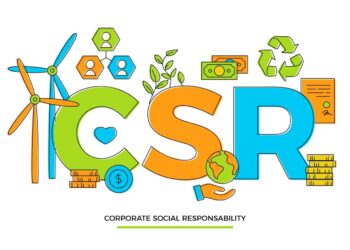Longer gestation periods and extended completion phases in restoration, compared to social activities, a lack of qualified implementing agencies and the absence of enabling policy interventions, make restoration a challenging CSR activity for corporates.
By Mohan Chandra Pargaien
- In the UN Decade on Ecosystem Restoration, Indian states also need to re-evaluate the existing mechanisms and policy frameworks keeping the restoration objectives in mind and formulate strategies to facilitate the active involvement of corporates.
- Tree planting or forest restoration has now become one of the important routes to achieve net zero targets by 2070 as committed by India at the climate conference COP26 conducted last year in Glasgow.
There is no doubt that businesses, irrespective of their size, contribute to a large carbon footprint while pursuing the aim of maximising profit. India became the first country in the world to make corporate social responsibility (CSR) mandatory through the Companies Act (2013), requiring all companies that meet a specified financial limit to spend 2 percent of their average net profit towards CSR activities. The latest shift from the existing Business Responsibility Reporting (BRR) to Business Responsibility and Sustainability Reporting (BRSR) as mandated by the Securities and Exchange Board of India (SEBI) is a welcome move, to provide opportunities and a desired platform to execute larger social and environmental functions by the companies.
Driven by leading international standards, Principle 6 of the RBC (Responsible Business Conduct guidelines) expects the corporations to make efforts to protect and restore the environment. The shareholders and consumers are now driving the sustainability agenda of corporations with a special emphasis on the environment. It has more relevance for a country like India with challenges like poverty and a degraded environment and an intricate linkage between the two.
The contribution of businesses towards restoration efforts in India as reflected in its report on the Bonn challenge has not been so encouraging — out of 9,810,944.2 hectares of the total area brought under restoration in six years, only 193,290.3 hectares (2%) was reported to be done by private companies. This data, however, may be not a true reflection because of limitations in data collection. As stated recently by CDP, an international non-profit organisation, there are reports of Indian corporates not disclosing the full information of their impact on the climate crisis, water shortage and deforestation.

There is a bias towards certain activities like education, poverty and health and environment has taken a backseat in CSR fund allocation. Photo from the CSR data portal, Ministry of Corporate Affairs (As on 14th March, 2022).
There are however, many examples of the remarkable contribution of corporate in environmental conservation towards forest restoration, including tree planting, in addition to their mandatory compliance. Initiatives like Project Hariyali of Mahindra, Sustainable Agroforestry model of ITC Ltd, Afforestation projects of NTPC Ltd, Lake restoration of Allergan, an AbbVie company, are a few among many initiatives associated with restoration activities including tree planting taken up by corporates.
Why is environment a decreasing priority?
In comparison to other equally challenging social issues such as education, poverty, health, sanitation etc., which the companies have been prioritising in the past, the environment and related issues somehow failed to gain the desired priority. A cursory look at CSR spending of the last seven years in Corporate Social Responsibility Data Portal of India’s Ministry of Corporate Affairs, reveals that the spending under CSR is mostly concentrated towards education with an average spending of 38% towards the sector, while other spending was in health and sanitation (22%) and rural development (10%), followed by the environment sector (8%).
Even under the environment sector, the favoured areas for spending are initiatives such as renewable energy projects, awareness or green initiatives with a meagre allocation for tree planting, rejuvenation and restoration of natural resources like water bodies, forests, grasslands etc. The agroforestry sector however, received a marginal continued funding, thus supporting the objectives of both livelihood and carbon sequestration. This bias towards education, poverty and health with sanitation has remained the same since 2014, which needs proactive re-examination and some corrective actions.
The need to focus on restoration
Forests with their spectacular capacity of carbon sequestration also offer an opportunity to assist in achieving net-zero targets. However, this requires the participation of all stakeholders. The UN Decade on Ecosystem Restoration aims to halt and reverse the degradation of ecosystems on every continent and in every ocean. To restore 350 MHA of degraded land by 2030 globally, and 26 MHA in India, restoration needs to be prioritised under various environmental initiatives of governmental, non-governmental and private organisations including corporate. The decreasing budget of forest departments in many of the states is also a cause of concern which can be compensated by corporate to some extent from their CSR funds.
Challenges for corporates in bringing restoration under CSR
Among various challenges that corporates face while adopting restoration programmes, including tree planting is its long gestation period and extended completion phase in comparison to other social activities. This along with the lack of qualified implementing agencies including NGOs and the absence of enabling policy interventions for hassle-free selection of areas including degraded forests, make this challenge more difficult to translate this priority into action.
Forest restoration activities, being technical, also need suitable training and capacity building interventions. The state forest departments also need to be a very active partner for ensuring the availability of quality planting material and required technical guidance for other forest restorative activities. Whether the areas targeted are inside the forests or outside the forests in private or institutional lands, we need to take care of the interest of communities duly providing necessary ways and means to take care of their interests to make our approach participatory for an effective and successful outcome.
Apart from these obstacles, there have been instances of geographical biases, convenient interpretation of activities, camouflaging and lack of commitment among companies undermining the sole objective of achieving goals of sustainability. The 2020 research by WWF, Tree Planting by Businesses, for European countries, states that there is little or no evidence that they (businesses) pay enough attention for tree planting, or to the role of trees in a wider perspective and the emphasis is clearly on the number of trees planted. This warrants attitudinal change among corporate to facilitate a gradual shift of preference towards multipurpose forest restoration rather than just tree planting.
The path forward
Indian corporate being the major agent of the development process also carries the responsibility to maintain a balance between development and environment. Corporates need to utilise these mandated provisions as an opportunity to become a change agent for sustainable development by looking and acting towards environmental goals beyond CSR mandates, duly refraining from geographical biases, camouflaging and greenwashing.
There is a need for a prioritised shift from the social sector to the environmental sector with much focus on carbon-sequestering channels like Afforestation and restorative approaches by Indian Corporate under their spending pattern of CSR. The networking of implementing agencies especially NGOs, their capacity building and training with suitable incentives have to be ensured through an integrated approach with the involvement of all players. The states also need to re-evaluate the existing mechanisms and policy frameworks keeping the restoration objectives in mind and formulate strategies to facilitate the active involvement of corporate. This reoriented and renewed approach of the corporate can help to bring a real balance between business and environment and help India to achieve its net zero targets.
The author is a Senior IFS Officer in Telangana. He tweets as @pargaien.
The views in this commentary are that of the author.
Article first appeared at Mongabay-India.






















